The difference between sonata and cantata, from a basic linguistic context is that a cantata is music that is sung and a sonata is played. So, if I were to draw parallels to nature, the Indigo Bunting that was passing through at the Genuine Faux Farm yesterday as it migrated was participating in nature’s cantata. The rustling leaves of the cottonwood tree, on the other hand, probably would be considered part of the sonata.
Not that long ago, I wrote about the Conehead and Katydid Symphony, which consisted of insects that use their bodies as instruments. They don’t have voices in the traditional sense - at least as far as humans see it. Which brings me to today’s question.
Is it possible that sunflowers create their own music? If so, what it is it like?
We try to plant sunflowers somewhere on the farm every year and have very rarely missed the timing or failed to plant them. The great thing about sunflowers is that there is a long window in Iowa where you can put seeds in the ground and actually enjoy their blooms before the cooler weather removes the opportunity. I’ve frequently considered succession plantings for sunflowers to extend the peak bloom season, but I typically just plant multiple varieties with different days to maturity instead.
I guess you could say I enjoy the Sunflower Sonata enough that I’d like to hear it a bit longer.
Perhaps next year will be the year that I manage to do successions. It’s among the hundreds of little experiments I have roaming around in my head that I think I might like to try some day. The issue is always in the follow-through. Multiple successions requires multiple bed preps and multiple planting dates - along with different cultivation schedules. That’s not so bad if you’re not growing other crops, holding down an off-farm job and/or trying to do other experiments too.
So, of course, I DO grow other crops and I DO hold down the off-farm job and I DO try to do other experiments.
Maybe I’d better stick to the different varieties approach.
Parts of the sonata are played by organisms other than the sunflowers themselves.
Sunflowers attract a range of bee pollinators, but it’s the big bumblebees that attract my attention the most. As you would think, this is for obvious reasons. Bumblebees make the most noise when they fly and they aren’t the most nimble fliers - almost having to bump into other objects to change directions. And, when the flowers themselves are a few feet above your head, it’s pretty difficult to check for the smaller insects.
Obviously, bees aren’t the only insects a person can find on a sunflower. I’ve seen various beetles including some I typically am not as happy to see - like the Spotted Cucumber Beetle and the Corn Rootworm Beetle. But it turns out beetles are also pollinators, which is called cantharophily. And, sometimes I will see different kinds of flies and butterflies as well.
Now that we’re deep into September, there are very few blooms remaining. Instead, we have seed heads that are beginning to dry out. The Goldfinches will be checking the flowers out soon for a meal or three. They, of course, have their own cantata to sing. But, since it is Fall, they are more prone to simply exclaiming “FOR ME?!” as they hop from one stalk to another.
We know other birds enjoy the seeds as well, which is why we leave the stalks through the cold months. Our feathered friends appreciate the seeds and the berries on some of the bushes we’ve planted over the years - and we appreciate their presence in return.
We haven’t had many Monarchs at the farm this year, which is a very sad state of things, in my opinion. I fondly recall earlier years at the farm where we would have dozens of these flying gems checking out each long row of zinnias and sunflowers. It wasn’t until recently this year that I’ve seen more than one Monarch at a time at the farm. Prior to that, I never did see more than one monarch on any given day. And most days, I saw none.
Happily, one of the Monarch sightings was in the sunflower patch. Even better, I had the camera out because I wanted to get some pictures of this year’s blooms. This Monarch lazily flew over head and then selected a flower not far away to land. As it tasted the nectar and soaked up the warm sun, I crept up as close as I dared.
Then I let myself be dazzled for a while… and almost forgot I had the camera. But as you can see above, I came out of the trance enough to catch it spreading its wings in a prelude to its next flight.
Did you know that if there is very little breeze and things are quiet AND you listen very carefully, you can hear the flapping of a butterflies wings?
If you’ve ever picked a stem or two as a cut flower, you’ll know sunflowers like to leave their pollen sprinkled on the surface of the table or desk or whatever thing you decide to display it. While this might be annoying to some who prefer pristine housing interiors, it turns out that sunflower pollen can actually be beneficial for bees and, in particular, bumblebees!
Sunflower pollen has a spikey exterior (which is also true for related plants - such as goldenrod). And, it turns out that, at least for the Common Eastern Bumblebee, that the spikey pollen from these plants helps them to deal with a common parasite (Chrithidia).
But, before we make the mistake of deciding that sunflowers are a superfood for all bees, the existing studies have not found this to be a universally effective treatment for all bee species. On top of that, sunflower pollen is low in protein, so it is not sufficient to stand as the only food source available if we are interested in healthy bee populations.
Of course, we should not be terribly surprised by this. Nature often uses diverse diets to build up health. Even so, having this information only encourages me to continue to let the goldenrod stay where it has popped up on the farm. It may also encourage me to trial that planting succession idea to extend the bloom season of sunflowers too.
If you decide to grow sunflowers to support pollinators, remember to get open-pollinated varieties. Remember the pollen on the kitchen table (and everywhere else) that came with cut sunflowers on our farm? Well, some people aren’t happy with that - especially if they have severe pollen allergies. As a result, many hybrids have been developed that have little or no pollen. They will be of no help to the bees.
Sunflower varieties exist that range from a few feet in height to twelve feet. The open pollinated varieties I’ve paid most attention to range from yellows to rusty reds in color. Some will have multiple stalks at the top, each bearing a flower. Others will feature a single stalk with a very large flower. You can actually see examples of each in the picture above.
All of the varieties we have grown over the years have come from Seed Savers. This makes sense for us because we support their mission and their main growing facility is only an hour’s drive from our farm. Often seed that is regionally sources will perform better than seed that comes from a very different environment.
I know some people who read this blog are now wondering which varieties we have tried and what we thought of each. I will say that Autumn Beauty, Lemon Queen and Velvet Queen have been long standing favorites at the Genuine Faux Farm. Sometimes we grow Ring of Fire, Irish Eyes, and/or Arikara. And, occasionally we will grow something with the absurdly big flowers, like Rostov or Mammoth Russian.
I will admit that I’ve never spent much time trying to differentiate whether the pollinators like one of these varieties more than others (oh no! Another future experiment!). But my sense has been that the pollinators will go where the flowers are in peak bloom. If Lemon Queen is at the tail end of their bloom and Autumn Beauty is picking up the slack, then Autumn Beauty tends to have the pollinators. It makes sense, but it does nothing to provide you with a recommendation for best single variety for pollinators.
Sunflowers are typically big enough that they can look great from a distance AND provide a source of enjoyment up close and personal! I find the disk where the seeds develop to be full of color and textures that invite you to stand around an observe them for a while. And if I were a commercial sunflower grower, I might actually spend more time learning the names of all of the parts.
The picture shown above gives you a close up view of a flower before the seeds have formed. Sunflowers actually have two “types” of flowers (for lack of a better way to say it). There is the unit as a whole and then there are smaller “flowers” for each developing seed. They are labeled as “disk florets” in the image below.

Another neat thing about sunflowers is that the seeds create a spiral pattern that rotate both ways towards the center of the seed head. It turns out that the number of spirals in each direction will be a different number of spirals. But, each of those numbers will be consecutive numbers of the Fibonacci sequence. (Darvas, G. (2007) Symmetry: Cultural-historical and Ontological Aspects of Science-Arts Relations. Basel: Birkhäuser Verlag.)
Apparently the Sunflower Sonata has connections to mathematics, just as music does.
For those who are not familiar, the Fibonacci sequence starts with the numbers 0 and 1. The next number is created by adding the previous two numbers. So, the 3rd number in the sequence is 1. The 4th number would be the sum of the 2nd and 3rd numbers - 2.
So the fibonnaci sequence is 0, 1, 1, 2, 3, 5, 8, 13, 21, 34, 55, etcetera.
According to Darvas article, if I counted the spirals on this sunflower head, each would come out to be a number in this sequence. Not only that, they would be adjacent numbers in the sequence (like 34 and 55). How cool is that?
If this isn’t making sense to you, I suggest you take this link. It has some helpful illustrations.
The Sunflower Sonata is visually bright and often domineering of the landscape around it. The blooms and the size of the plants draw our attention like few other flowers can. You would almost expect that their music would be equally brash, with lots of percussion and maybe blaring horns. Something that might be a bit like Mars, the Bringer of War in Holst’s Planets, perhaps.
Instead, I have found that the music of the sunflowers is best heard on a calm days when there is little to no wind. The buzz of a bumblebee and the light rustle of the leaves require your full attention and silence on your part to hear them. Sometimes, if you listen closely, you might almost be able to hear them grow.
Or maybe, the Sunflower Sonata is simply the music that plays in your mind as your heart smiles at the sight of them. Either way, it’s a piece of music worth listening to.





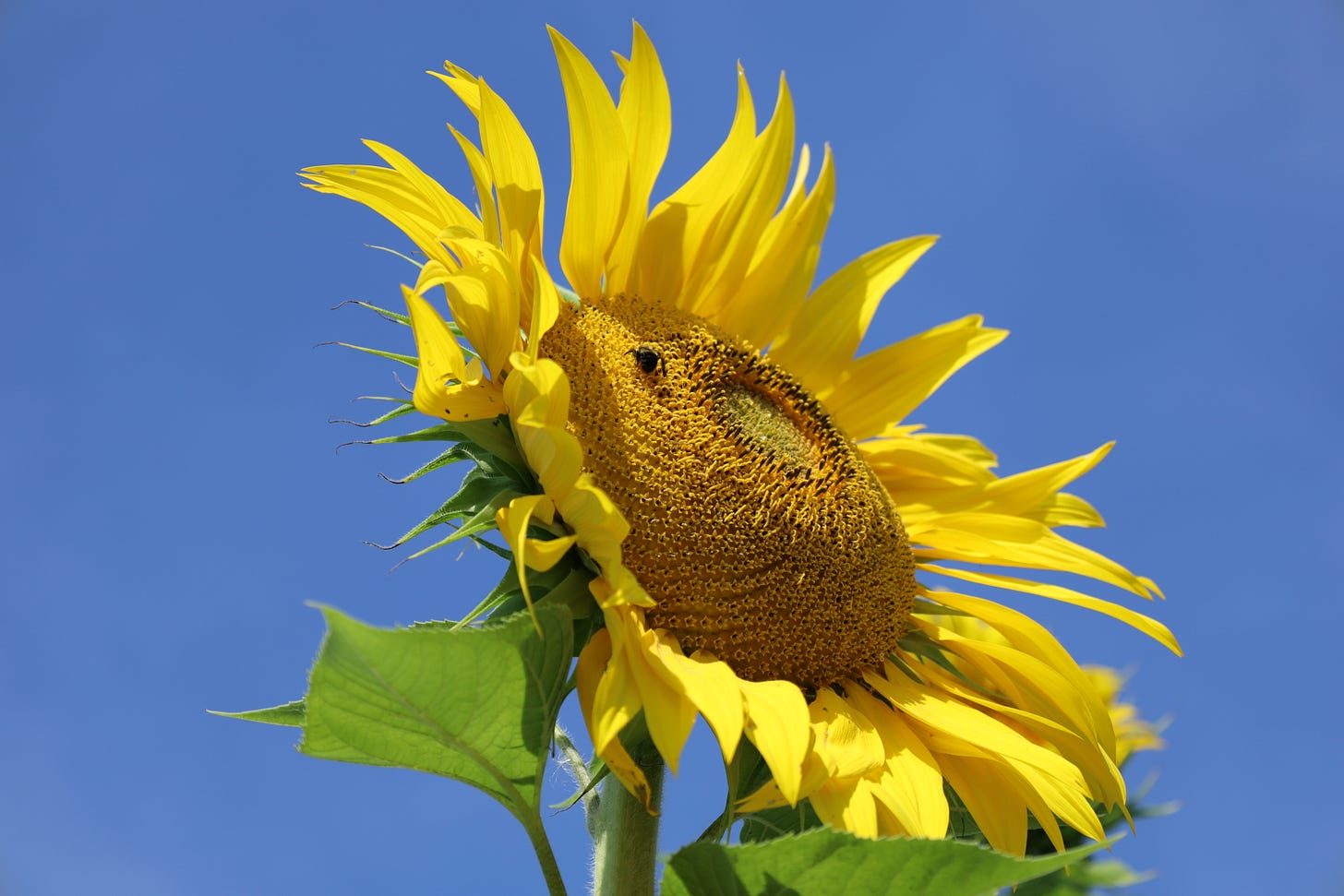
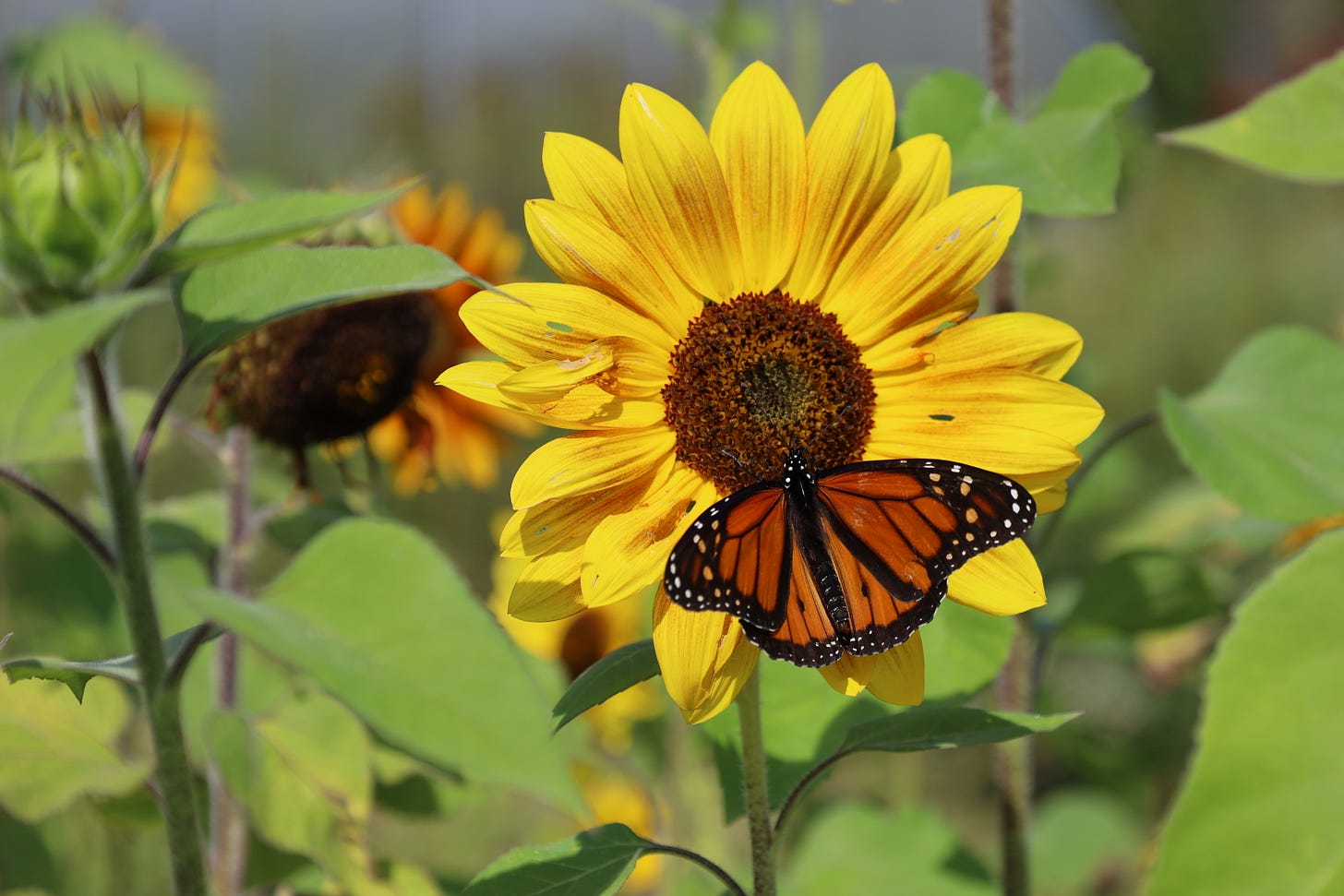
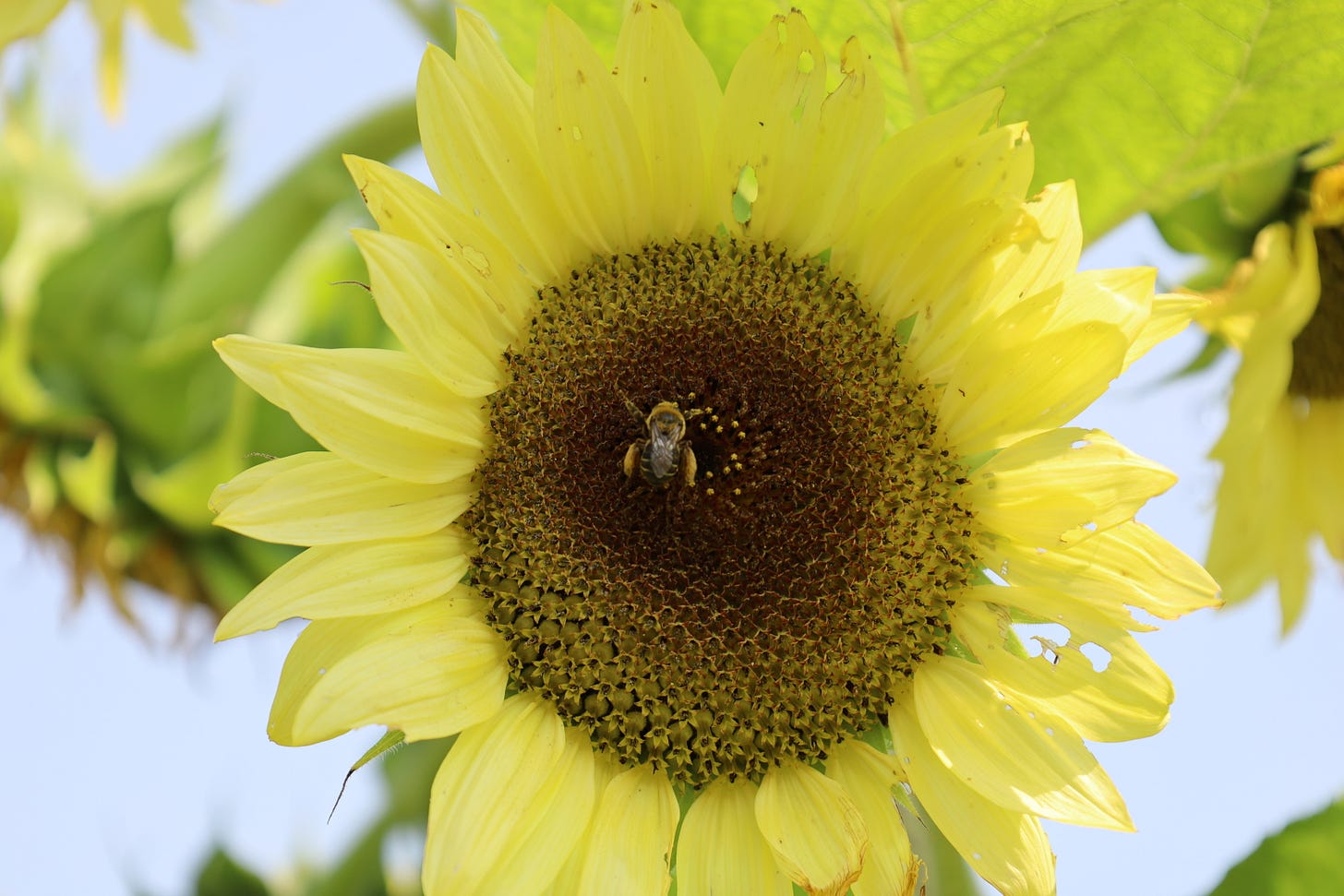
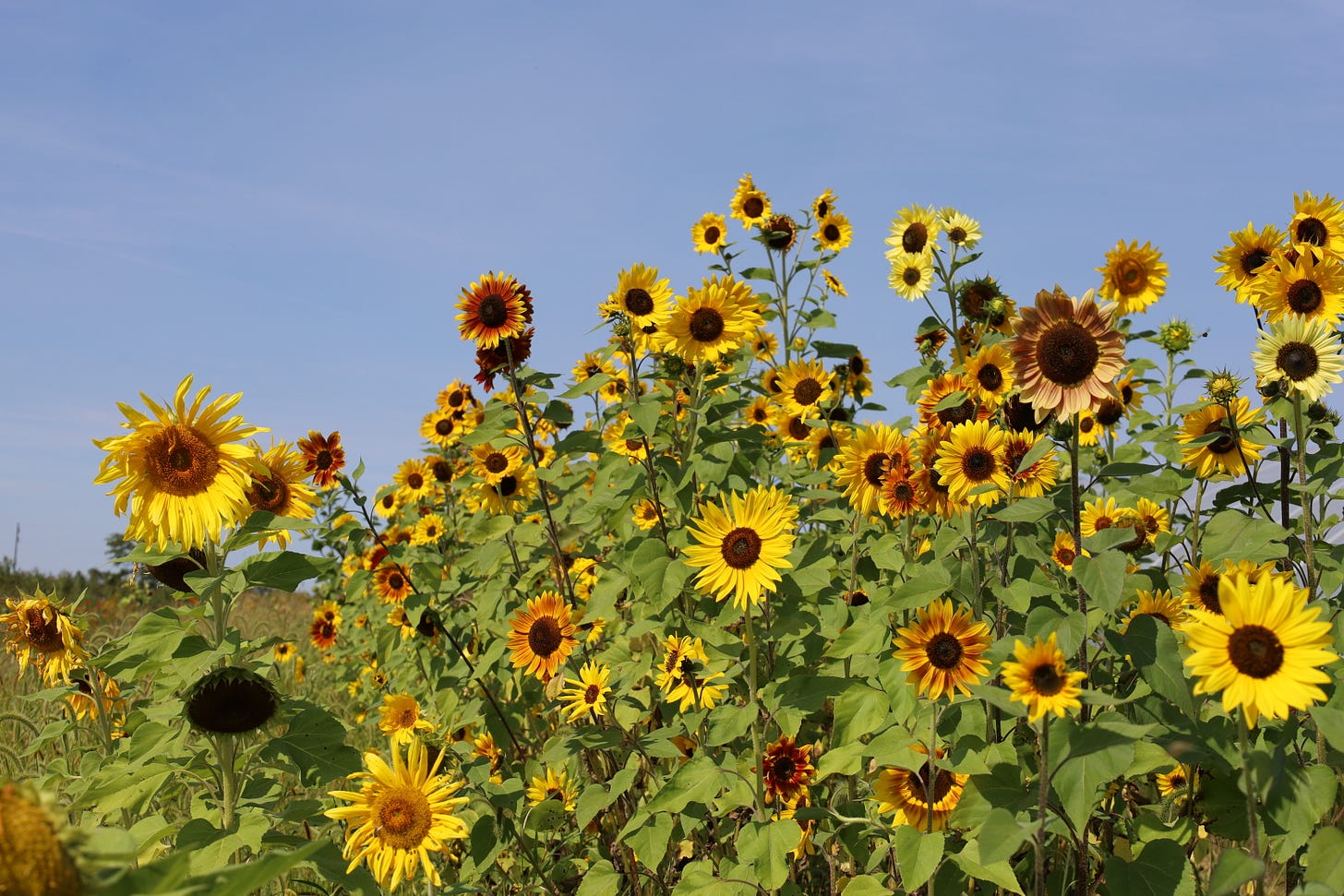
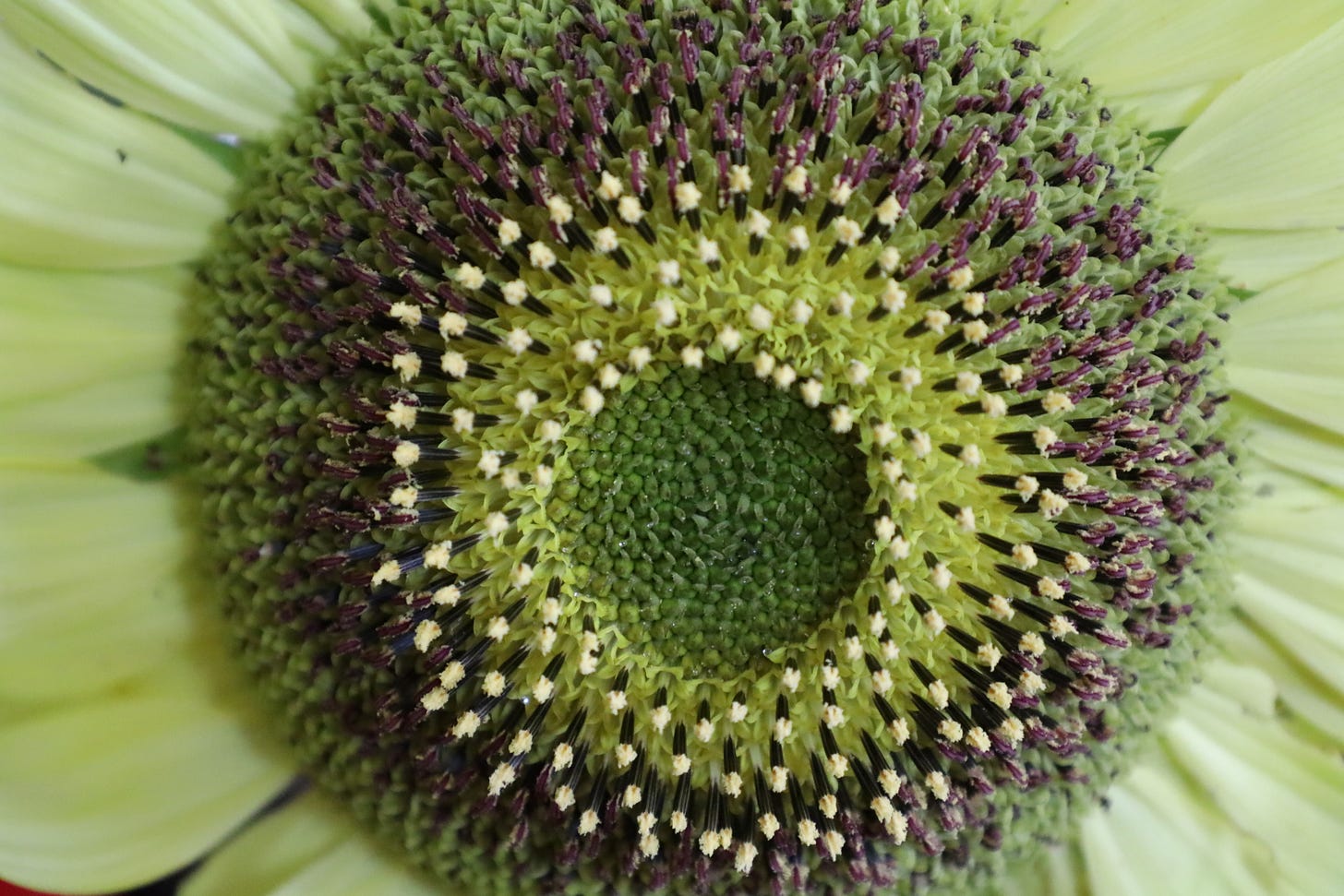
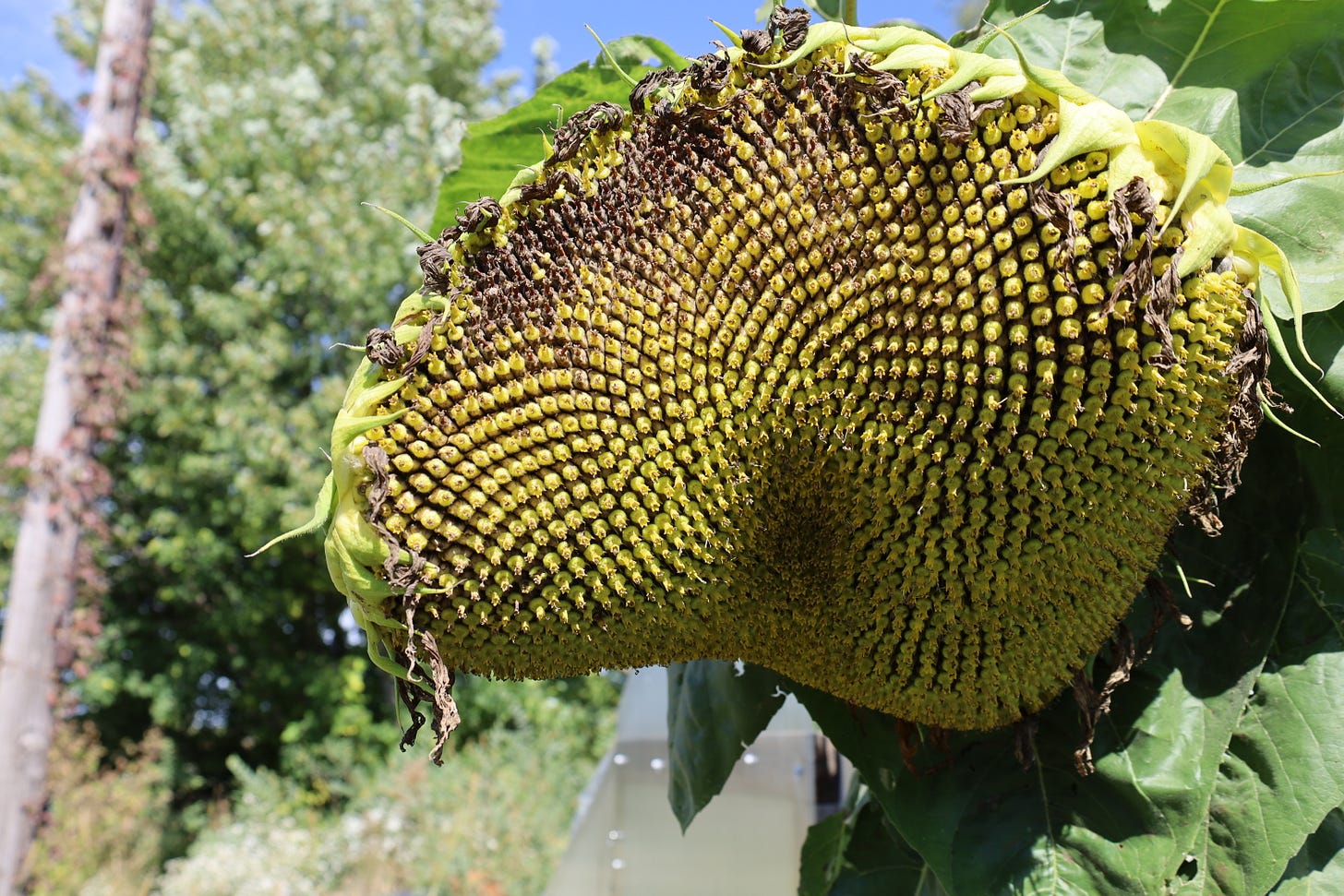
Thanks for the sunflower information, Rob. I aways come away from your musings a lot smarter than I began. Of course as I was reading, I was waiting (patiently) for the Fibonacci sequence to be mentioned. Please keep sharing your mind rumblings with us.